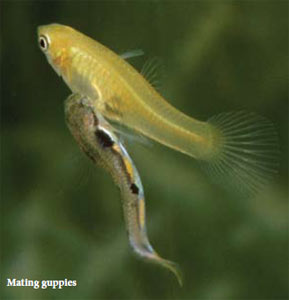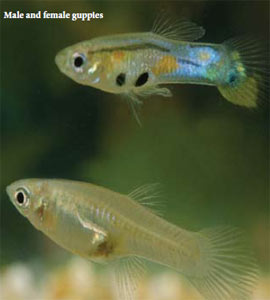 |
 |
 |
|
January 2012
|
Research by biologists at the University of St Andrews (Dr Amy Deacon and Professor Anne Magurran) and The UWI (Professor Indar Ramnarine) on this popular ornamental species, reveals how its ability to keep on reproducing has earned the guppy its reputation as one of the world’s most invasive fish. The study, published recently in the journal PLoS ONE, reports that the apparently harmless release of guppies into the wild has led to the fish being found in every continent with the exception of Antarctica. The guppy, whose native home is Trinidad and the north-eastern fringe of South America, is now present in over 70 countries worldwide. Since a single female guppy can establish a viable new population, the research demonstrates that even well-intentioned releases of unwanted pets can contribute to the loss of biological diversity. St Andrews lead researcher Dr Amy Deacon commented, “Our findings show that the range of the guppy has expanded dramatically since the early 1900s.” The scientists began by surveying hundreds of fish biologists around the world.
In places such as Southern India, guppies are routinely released into water troughs, wells and small ponds for mosquito control. Although self-contained at first, heavy rains and flooding mean that the fish eventually find their way to streams and rivers where they come into contact with native fish. Dr Deacon continued, “Usually only one or a few fish are released. We know that the vast majority of species introduced to a new habitat in this way are unable to survive, let alone establish a population, which left us with a huge question mark.” To try to solve this mystery, the researchers conducted a simple experiment at UWI, in which single wild female guppies were placed into outdoor tanks. After two years, they discovered that almost all of the tanks contained populations of guppies, each founded by just one female.
“We also found that these populations kept all of the important behaviours that wild guppies have, so they would be well-equipped for surviving in a new environment.” Dr Deacon continued, “Our study shows why we should be cautious when releasing exotic species.” “Seemingly harmless activities such as a child freeing a few pet fish can ultimately contribute to the reduction of biodiversity in freshwater habitats across the world.” The research, published by the journal PLoS ONE in September 2011, was funded by the Natural Environment Research Council and the European Research Council. |


 The release of a single female guppy into the wild can generate entire new populations, even with no males present, according to new research.
The release of a single female guppy into the wild can generate entire new populations, even with no males present, according to new research. Responses confirmed that the two most important routes of guppies finding their way into the wild are the escapes of ornamental fish, and deliberate introductions designed to control the larvae of mosquitoes that spread malaria.
Responses confirmed that the two most important routes of guppies finding their way into the wild are the escapes of ornamental fish, and deliberate introductions designed to control the larvae of mosquitoes that spread malaria.  Dr Deacon explained how this finding might explain their success as an invasive species, “Sperm storage is an excellent adaptation for living in constantly changing habitats, and it might also explain the guppies’ global success. Female guppies can store sperm in their reproductive tracts for many months after mating, and this enables single fish to establish populations, even when no males are present”.
Dr Deacon explained how this finding might explain their success as an invasive species, “Sperm storage is an excellent adaptation for living in constantly changing habitats, and it might also explain the guppies’ global success. Female guppies can store sperm in their reproductive tracts for many months after mating, and this enables single fish to establish populations, even when no males are present”.